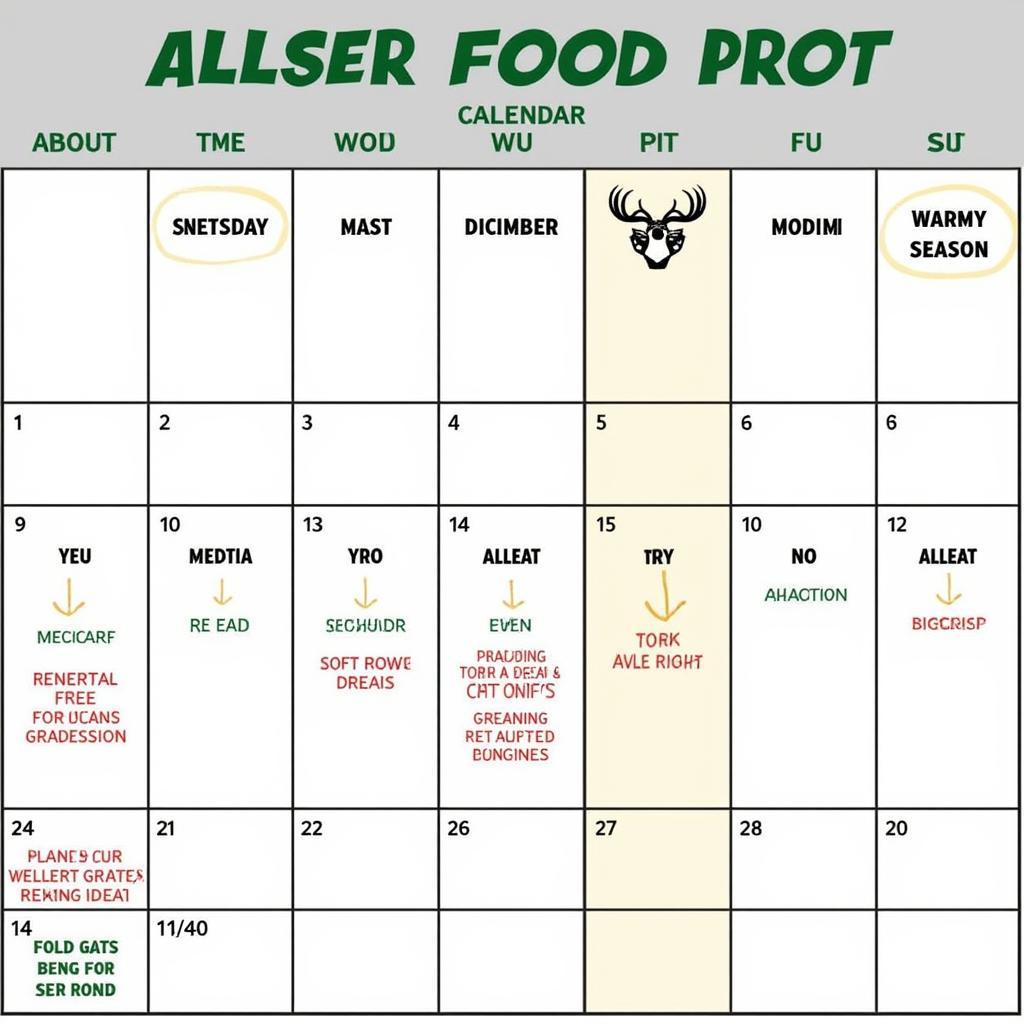Knowing When To Plant Fall Food Plots is crucial for hunting season success. While the specific timing depends on your location and the type of plants you choose, understanding the general principles can significantly improve your chances of attracting and keeping deer on your property.
 Fall Food Plot Planting Calendar
Fall Food Plot Planting Calendar
Understanding Your Region’s First Frost Date
The first and most crucial factor influencing your fall food plot planting schedule is your region’s average first frost date. This date varies considerably across North America, so consulting a local agricultural calendar or a USDA Plant Hardiness Zone Map is essential.
Why is the first frost so important? It marks the point where most warm-season plants, like soybeans and corn, cease their growth cycle. On the other hand, cool-season plants, such as cereal grains and brassicas, thrive in cooler temperatures and can withstand frost, making them ideal for fall food plots.
Timing Your Planting for Optimal Growth
6-8 Weeks Before the First Frost: Plant Cool-Season Food Plots
Ideally, aim to sow cool-season food plot seeds about 6-8 weeks before your region’s average first frost date. This timeframe allows enough time for the seeds to germinate, establish a healthy root system, and accumulate sufficient growth before winter sets in.
Examples of popular cool-season food plot options include:
- Cereal grains: Wheat, oats, rye
- Brassicas: Turnips, radishes, rape
Planting within this window ensures your food plots are lush and attractive when deer begin actively seeking nutrient-rich forage in the fall.
Consider a Late Season Food Plot for Added Attraction
late season food plot can be a game-changer for extending the appeal of your property throughout the hunting season.
2-4 Weeks Before the First Frost: Plant Quick-Growing Options
If you’re working with a shorter timeframe, there are still viable options. Certain varieties of cereal grains and brassicas are known for their quick growth and can be planted 2-4 weeks before the first frost. While they may not achieve the same biomass as those planted earlier, they can still provide valuable forage.
Factors Affecting Planting Dates
While the first frost date serves as a general guideline, other factors can influence the ideal planting time:
- Elevation: Higher elevations tend to experience frost earlier than lower-lying areas.
- Microclimates: Variations in sun exposure, soil drainage, and wind protection can create microclimates within your property, affecting planting times.
- Specific Plant Requirements: Different plant species and even varieties within a species may have slightly different optimal planting windows. Always refer to the seed packet instructions for specific recommendations.
Planning Your Fall Food Plot Strategy
Consider a Mix of Plantings
Planting a variety of cool-season options can further enhance your food plots’ attractiveness. Deer have different nutritional needs throughout the fall, and offering a diverse menu keeps them coming back for more.
- Chicory for Deer Food Plots: This perennial plant provides nutritious forage and can tolerate browsing pressure well, making it a valuable addition to your mix.
- Radish Food Plot for Deer: Radishes are known for their rapid growth and palatability, serving as an excellent early-season attractant.
Soil Testing and Preparation
Just like your garden, healthy food plots start with proper soil preparation. Conduct a soil test to determine the pH level and nutrient content. This information will help you choose the right fertilizers and amendments to create optimal growing conditions.
The Rewards of Timing Your Planting Right
By carefully considering your region’s first frost date and other influencing factors, you can time your fall food plot planting for maximum impact.
“Understanding the rhythm of nature and aligning your planting schedule accordingly is key to creating irresistible food plots that draw deer to your property,” says wildlife biologist Dr. Emily Carter.
A well-timed and well-planned food plot strategy not only benefits your hunting success but also contributes to the overall health and well-being of the local deer population.
Frequently Asked Questions About Fall Food Plots
When should I plant fall food plots in Michigan?
michigan food plot planting dates typically fall between late August and early October, but it’s best to consult a local calendar for specific recommendations.
What is the best year-round deer food plot?
Choosing the best year-round deer food plot involves a combination of cool-season and warm-season plants to provide continuous forage.
Can I plant food plots too early?
Yes, planting too early, especially warm-season plants, can lead to issues with disease, pests, or reduced growth due to summer heat.
What should I do if my food plot doesn’t come up?
Several factors can affect germination. Consider re-seeding, adjusting soil conditions, or consulting with a local expert for advice.
Need Help with Your Food Plot?
Planning and planting food plots can be a rewarding endeavor. For personalized guidance and support, contact Mina Cones Food. Our team of experts is dedicated to helping you achieve your food plot goals.
Contact us today:
Phone: 02437655121
Email: [email protected]
Address: 3PGH+8R9, ĐT70A, thôn Trung, Bắc Từ Liêm, Hà Nội, Việt Nam.